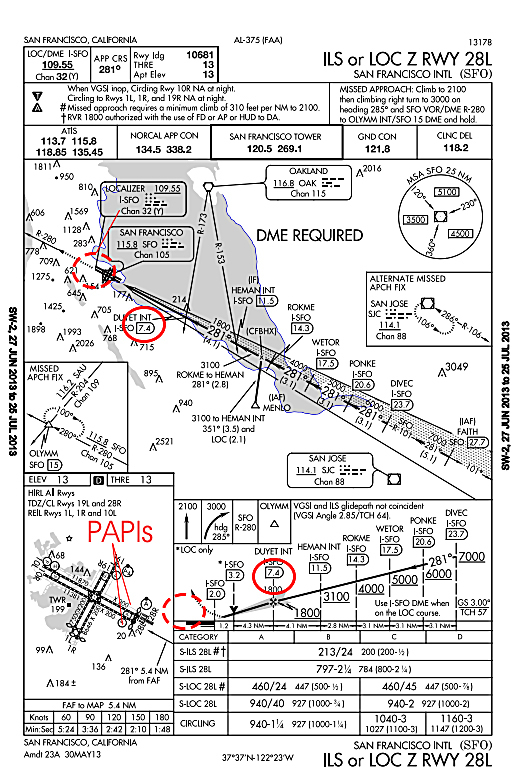On Saturday, Asiana Airlines flight 214 crashed on the final stages of approach to San Francisco's runway 28L (magnetic track of 280 degrees and the left runway of two parallel landing strips). What we do know is that a board of inquiry, convened by the NTSB and aided by Boeing, will conduct a thorough investigation into the cause(s) of the accident. To ameliorate conjecture and speculation, the following information may be useful, harnessed from 20 years of flying fixed wing aircraft and helicopters in the military, combining over 3,000 hours of airtime and many hundreds of instrument approaches to civilian airfields under both VFR and IFR flight conditions.
The nature of such an inquiry takes months to reach its conclusions and definitive results may never be ascertained. The myriad of considerations for the investigation team includes; radar data, feedback from air traffic control (including tower and terminal approach controllers), instrument analysis from the flight data recorders (in particular engine and flight instruments, voice, radio frequencies and warning alerts) and interviews with qualified personnel from pilots to cabin crew.
Eyewitness accounts from passengers and observers may produce dramatic reports but are no indication of accurate events. It is almost impossible for the untrained eye to have a true sense of what altitude the aircraft should be at without knowing the distance to the runway's threshold (the beginning of the runway usually indicated by white markers that have a similarity in appearance to 'piano keys'). A typical glide slope's gradient is 300 feet per nautical mile. So for example, an aircraft five miles from touch down should be at or around 1500 feet.
Depending on whether the pilot is conducting an approach under VFR or IFR, gauging the accuracy of the approach will differ. Under IFR the pilots will have an approach chart for the runway in use. I have included the chart for San Fransisco's runway 28L below and highlighted certain key snippets of information. The information made available tells us that the pilots need to be at 1800ft when the DME is reading 7.4 miles (red solid circle). Important to note is that the Distance Measuring Equipment or DME (transponder based radio-navigation equipment) is located at the other end of the runway and two miles away from the 28L threshold (dotted red circle). Ergo, the aircraft should be at 1800ft and 5.4 miles from the 28L threshold.
Under a VFR approach, it is not unusual for the pilots to have the IFR chart available as it offers a plethora of useful information from radio frequencies to airfield layout. When the pilots look out of the window they also have available the Precision Approach Path Indicators (PAPIs). These are two boxes either side of the runway with four lights positioned horizontally next to each other. Four reds lights indicate that the pilot is well below the glidepath; four white lights well above; and two reds and two whites indicate that the pilot is on the glidepath.
We also know that there was debris trailing from the seawall. This indicates that part of the aircraft struck well before the threshold. The pilots will have had plenty of indications to access their approach through either the aircrafts instruments (gauged against the chart) or through the PAPIs. But visual approaches to runways that protrude into the sea are more complex than those surrounded by land. When a pilot makes a visual approach over large water masses, ascertaining speed, rate of decent and rate of closure becomes harder, especially over a calm or glassy surface. It is therefore incumbent on the crew to make regular cross-checks with air speed indicators and altimeters inside the cockpit. Any corrections in height will be made through engine power and throttle selection.
It is clear that flight 214 struck the ground short of the runway threshold. This indicates that the aircraft was below the glidepath in the final stages of the approach. For how long the aircraft was below the glidepath and why the aircraft was below the glidepath will only be ascertained by the NTSB. The information above will hopefully give you a snapshot of what techniques, equipment, charts and instruments were available to the pilots of Asiana Flight 214 and serve to ameliorate the rampant conjecture that seems to accompany such tragic accidents.
